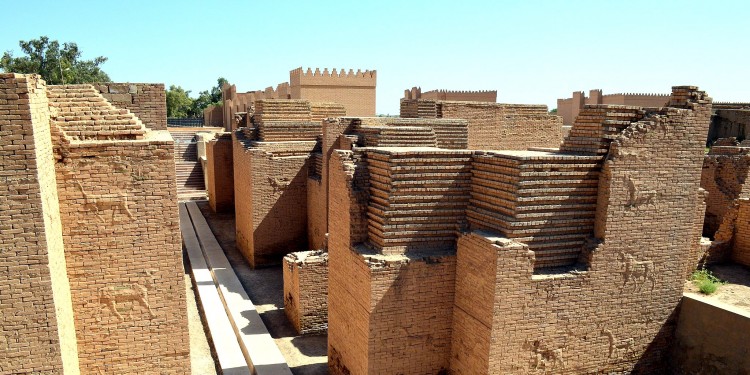
Clay tablets reveal styles of governance
Quite a few of the antique clay tablets which Prof. Kristin Kleber works with look as if a chicken has walked across damp clay. That is what the non-specialist sees. For Kleber, however – an Assyriologist at the University of Münster – they are important sources of information about the way people in humanity’s first advanced cultures lived and thought. In particular, it is the cultural and linguistic wealth that fascinates her. “The ancient Near East has a three thousand-year-old history,” says Kleber. “A large number of textual sources have still not been researched.” Clay tablets are repeatedly being found in excavations in countries of the Near East. “Sometimes, a new archive opens up a region or aspects that we previously had no idea about.”
“Governance in Babylon: Negotiating the Rule of Three Empires” (GoviB) is the title of her project, for which the European Research Council has awarded her a Consolidator Grant with around two million euros for the coming five years. Or, to express it another way: How did governance function in the time between the 8th and the 4th centuries BCE – a period in which Babylon experienced two regime changes and three empires?
Kristin Kleber’s sources cannot, however, be read like a newspaper – especially as the tablets are often damaged. She deals with texts from the first millennium BCE, the age of the empires. Depending on the type of text, approximately 150 to 600 different signs for words and syllables were used, with many of them also having more than one meaning. “Reading them correctly is dependent on certain rules and on the context,” says Kleber.
She works mainly with the Sumerian and Akkadian languages. “Sumerian was the first written language in human history, and it died out around 2000 BCE,” she explains. “It continued to be used, though, just like Latin in the Middle Ages. Akkadian is a Semitic language – like Arabic and Hebrew – and we can understand it quite well.” For her edition, Kleber is first producing transcriptions of the cuneiform signs into our Latin alphabet. “Then we translate and give a commentary on difficult passages.” After that, the analysis of the content can begin.
Kleber’s focus is on legal and administrative documents, as well as letters. “These documents provide information about social and economic circumstances, indirectly about royal decrees and taxes, about families who held high office in the local administration or in the temple and about their relations with the royal administration.” Everyday texts are mixed up with library texts, she says, especially in the case of archives relating to priests. These religious, literary and scientific works show which principles and views were widespread. The state of preservation in the tablets varies greatly, though.
Unfortunately, Kleber reports, there has been an increasing number of illicit diggings since the Second Gulf War. The material stolen frequently turns up in the art markets in Europe, the USA, Israel and Japan – and then, regrettably, the archaeological contexts of such objects are lost forever, she says. “Groups of texts which originally belonged together, for example antique archives or libraries, have been scattered all over the world.” The texts for her current project come from legal digs undertaken by the Deutsche Orient-Gesellschaft (DOG) in Babylon. “On the basis of the so-called Division of Finds Agreement, most of them are today in the Vorderasiatisches Museum in Berlin. Some are kept in Istanbul, others are lost.”
The GoviB edition forms the empirical basis of Kristin Kleber’s project. Specifically, she hopes to find information on the two regime changes which Babylon went through round about the middle of the first millennium. In her view, the politics of the three empires differed greatly. “I’d like to find out what interactions emerged between the government and the local population, and in particular how each side responded and adapted to the other.” Governance was not always absolutist and despotic, she says. “Local groups had scope for action. They might not have been able to prevent imperial power being exercised, but they could put considerable obstacles in the way.” It is for this reason that Kleber is also interested in the tensions in the interplay between, on the one hand, behaviour guided by the benefits to be had and, on the other, adherence to a traditional local identity. “We have a similar problem in Europe,” she points out. “We come from a tradition of nation states but are united in the European Union.”
The tablets for the project were excavated between 1899 and 1917. It was only in 2005 that Olof Pedersén published a catalogue of the Babylonian texts – “a milestone”, says Kleber. A recently completed pilot project undertaken by the Freie Universität Berlin, the Vorderasiatische Museum and the DOG inventoried the Babylonian material and digitized the documentation relating to the excavation – a total of about 30,000 objects, plus maps, plans, find lists, diaries and packing lists. “Research on Babylon will be the hallmark of our subject, both in Germany and abroad, for the coming decades,” Kleber says.
The new findings from Münster are also to be digitized and made freely available online. “The Rectorate, the Faculty of History and Philosophy and the Faculty of Philology have recently supported an initiative by six ‘small’ subjects in the field of Ancient Civilization Studies for the establishment of a 3D laboratory,” Kleber reports. In addition to the clay tablets, including transcriptions and translations, the contexts in which finds were made are also to be reconstructed in 3D models – for example private houses and temples in Babylon.
Brigitte Heeke
Translation: Ken Ashton
